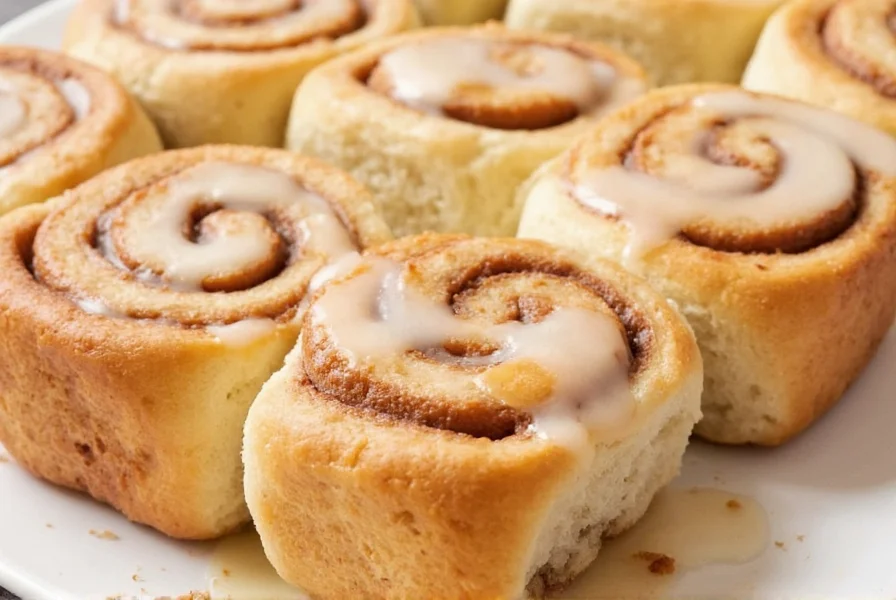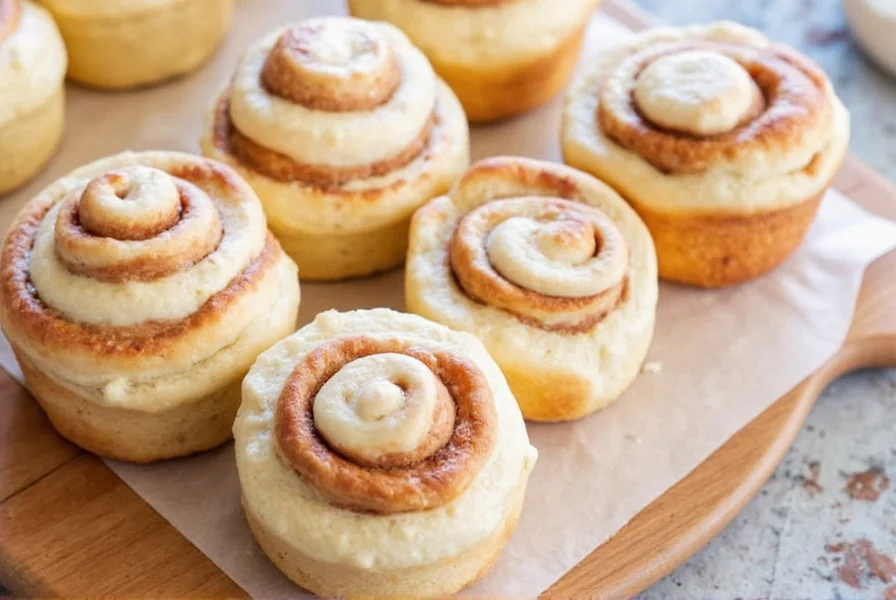There's nothing quite like the aroma of freshly baked cinnamon rolls filling your kitchen. Achieving that perfect balance of fluffy dough, rich cinnamon filling, and creamy frosting requires attention to detail and understanding the science behind the process. Whether you're a beginner baker or looking to refine your technique, this guide covers everything you need to know for consistently delicious results.
Essential Ingredients for Perfect Cinnamon Rolls
The foundation of exceptional cinnamon rolls begins with quality ingredients. While you don't need specialty items, using the right proportions and understanding ingredient functions is crucial.
| Ingredient | Amount | Key Purpose |
|---|---|---|
| All-purpose flour | 4½ cups (562g) | Provides structure; measure properly by spooning and leveling |
| Unsalted butter | ⅓ cup (76g), melted and cooled | Adds richness and tender texture |
| Whole milk | 1 cup (240ml), warmed to 110°F | Activates yeast and creates soft crumb |
| Granulated sugar | ⅓ cup (67g) for dough, 1 cup (200g) for filling | Feeds yeast and provides sweetness |
| Active dry yeast | 2¼ teaspoons (7g) | Rising agent; test for freshness first |
| Large eggs | 2, room temperature | Adds structure and richness |
| Ground cinnamon | 3 tablespoons | Essential flavor component; use fresh |
| Salt | 1½ teaspoons | Enhances flavor and controls yeast activity |
Pro tip: For the best cinnamon flavor, use Ceylon cinnamon for a more complex taste or stick with traditional Cassia cinnamon for that familiar bakery-style flavor. Always check your yeast's expiration date—old yeast is the most common reason for failed cinnamon rolls.

Step-by-Step Baking Instructions
Preparing the Dough
Start by warming your milk to 110°F (use a thermometer for accuracy—too hot will kill the yeast, too cold won't activate it properly). In a small bowl, combine the warm milk, 1 tablespoon of the sugar, and yeast. Let sit for 5-10 minutes until foamy, confirming your yeast is active.
In the bowl of a stand mixer with dough hook attachment, combine the remaining sugar, melted butter, eggs, and salt. Add the activated yeast mixture and 2 cups of flour. Mix on low speed until combined, then gradually add remaining flour ½ cup at a time until the dough pulls away from the sides of the bowl but remains slightly tacky.
First Rise
Transfer the dough to a lightly greased bowl, turning to coat all sides. Cover with plastic wrap and a clean kitchen towel. Let rise in a warm, draft-free place for 1-1.5 hours, or until doubled in size. For consistent results, aim for a room temperature of 75-80°F during rising.
Creating the Filling
While the dough rises, prepare your filling by combining 1 cup sugar and 3 tablespoons cinnamon in a small bowl. For extra flavor depth, add ¼ teaspoon of nutmeg or cardamom. Set aside 3 tablespoons of softened butter for spreading on the rolled-out dough.
Rolling and Cutting
Once risen, punch down the dough and turn it out onto a lightly floured surface. Roll into a 16x21 inch rectangle, working from the center outward. Spread the softened butter evenly over the dough, then sprinkle with the cinnamon-sugar mixture, leaving a ½ inch border around the edges.
Tightly roll the dough starting from the long side, pinching the seam to seal. Using unflavored dental floss or a serrated knife, cut into 12 equal rolls. Place in a greased 9x13 inch baking pan, leaving space between rolls for second rise.

Second Rise and Baking
Cover the rolls and let rise for 30-45 minutes until nearly doubled. Preheat oven to 350°F during the last 15 minutes of rising. Bake for 22-28 minutes until golden brown on top and 190°F internally. Don't underbake—this is the most common mistake when learning how to bake cinnamon rolls from scratch.
Cream Cheese Frosting
While rolls bake, prepare frosting by beating 4 ounces softened cream cheese, ¼ cup softened butter, 1 teaspoon vanilla, and ½ teaspoon salt until smooth. Gradually add 1½ cups powdered sugar until desired consistency. Frost immediately after removing rolls from oven.
Troubleshooting Common Cinnamon Roll Problems
Even experienced bakers encounter issues with cinnamon rolls. Here's how to solve the most frequent problems when baking homemade cinnamon rolls:
- Dense or tough rolls: Usually caused by too much flour or over-kneading. Measure flour properly by spooning into measuring cups and leveling—don't scoop directly from the bag.
- Rolls spreading too much: Dough may have risen too long during second rise or butter in filling was too warm. Keep second rise to 45 minutes maximum.
- Undercooked centers: Oven temperature may be inaccurate—use an oven thermometer. Try tenting with foil during last 10 minutes of baking.
- Burnt edges: Rotate pan halfway through baking or lower oven rack position. Consider reducing temperature by 25°F if your oven runs hot.
Variations for Different Dietary Needs
Adapting this classic cinnamon roll recipe for special dietary requirements is possible with these tested modifications:
For gluten-free cinnamon rolls, substitute with a quality 1:1 gluten-free flour blend that contains xanthan gum. You'll need to increase the liquid slightly (add 1-2 tablespoons more milk) as GF flours absorb more moisture. The texture will be slightly different but still delicious.
To make vegan cinnamon rolls, replace eggs with flax eggs (2 tablespoons ground flaxseed + 5 tablespoons water), use plant-based butter and milk, and ensure your sugar is vegan (some refined sugars use bone char). The dough may be slightly less elastic but will still rise properly.
Storage and Reheating Techniques
Proper storage maintains freshness and texture. Store cooled, unfrosted rolls in an airtight container at room temperature for up to 2 days. For longer storage, freeze rolls before frosting:
- Cool completely after baking
- Place on baking sheet and freeze until solid (about 2 hours)
- Transfer to freezer bags, removing as much air as possible
- Store up to 3 months
To reheat frozen cinnamon rolls, thaw overnight in refrigerator then warm in 300°F oven for 10-15 minutes. For best results when reheating, add a small bowl of water to the oven to maintain moisture. Never microwave cinnamon rolls if you want to preserve texture—this creates a gummy consistency.
Perfecting Your Cinnamon Roll Technique
Mastering how to make soft cinnamon rolls consistently requires attention to environmental factors. Humidity dramatically affects dough hydration—on humid days, you may need 2-4 tablespoons less flour. In dry conditions, you might need slightly more.
The secret to professional-looking swirls is rolling the dough tightly but gently—apply even pressure without stretching the dough. When cutting, use unflavored dental floss pulled through in one motion for clean edges without squishing the rolls.
Frequently Asked Questions
How long should cinnamon rolls rise before baking?
Cinnamon rolls need two rises: first for 1-1.5 hours until doubled in size, then after shaping for 30-45 minutes until nearly doubled again. The second rise is crucial for light, airy texture—don't skip it or shorten it significantly.
Why did my cinnamon rolls come out dense?
Dense cinnamon rolls usually result from too much flour, inactive yeast, or insufficient rising time. Measure flour properly by spooning into measuring cups (don't scoop), verify yeast is fresh and activated properly, and ensure complete rising in a warm environment (75-80°F).
Can I prepare cinnamon rolls the night before?
Yes, you can prepare cinnamon rolls ahead of time. After shaping and placing in the pan, cover tightly and refrigerate overnight. The next morning, remove from refrigerator 1 hour before baking to allow for proper second rise at room temperature.
What's the ideal internal temperature for baked cinnamon rolls?
Properly baked cinnamon rolls should reach an internal temperature of 190°F when measured with an instant-read thermometer. This ensures they're fully cooked without being dry. Underbaked rolls will measure below 185°F and may have doughy centers.










 浙公网安备
33010002000092号
浙公网安备
33010002000092号 浙B2-20120091-4
浙B2-20120091-4